The chilly, dark April makes our entrance into May all the more welcome!
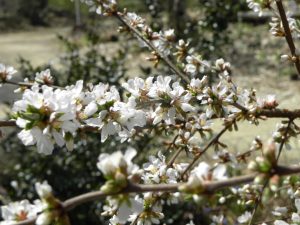
Nanking Cherry In Bloom
The weather has slowed down the start of serious gardening. It really feels more like the end of March. Both outdoor work and early harvests are behind schedule. There has still been plenty to do, however, and plants have been slowly appearing, some even blooming.
Our Work in April
We tackled some indoor projects this month, with mixed results.
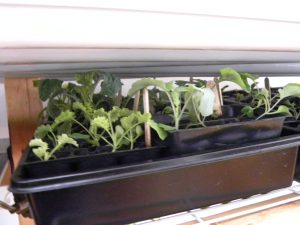 First, seed starting. I have been unhappy buying seed starting mixes. They generally have ingredients that I don’t feel good about using – such as peat and mined products like vermiculite – and come in a plastic bag. I feel like I ought to be able to make my own here. I have been growing amazing soil in our gardens, why not make this? Well, I guess I need to do a lot more research before I get it right. Last year I added worm castings from my indoor bin to a commercial mix. About ¼ castings. This meant I needed to use less of the mix. It went well. This year I did about half and half, and have not had good results, although I’m not sure it’s because of the amount of worm castings. Germination was mediocre, then the plants just aren’t growing straight and strong, and there was some yellowing of the leaves. There could be other reasons for the problems. For instance, I suspect I may have over-watered them early on. Still, I am going to have to rethink my soil mix for next season. All that said, I do have some seedlings growing well: lettuce, tomatoes, kale, broccoli, and eggplant.
First, seed starting. I have been unhappy buying seed starting mixes. They generally have ingredients that I don’t feel good about using – such as peat and mined products like vermiculite – and come in a plastic bag. I feel like I ought to be able to make my own here. I have been growing amazing soil in our gardens, why not make this? Well, I guess I need to do a lot more research before I get it right. Last year I added worm castings from my indoor bin to a commercial mix. About ¼ castings. This meant I needed to use less of the mix. It went well. This year I did about half and half, and have not had good results, although I’m not sure it’s because of the amount of worm castings. Germination was mediocre, then the plants just aren’t growing straight and strong, and there was some yellowing of the leaves. There could be other reasons for the problems. For instance, I suspect I may have over-watered them early on. Still, I am going to have to rethink my soil mix for next season. All that said, I do have some seedlings growing well: lettuce, tomatoes, kale, broccoli, and eggplant.
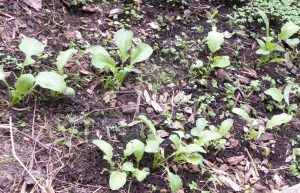
Radish, Carrots & Lettuce Emerging from Seed in the Hoophouse
I directly planted into our hoophouse beds: lettuce, radishes, and carrots. These were slow to come up with so little sun and warmth, but look great now.
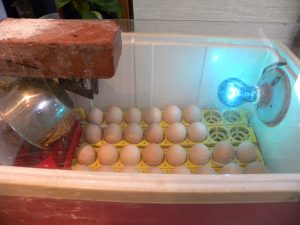
DIY Incubator (we’ll let you know if it works)
April is also a great month to incubate eggs (many people start earlier, but then have a bigger struggle keeping the brooder warm enough). However, the egg turning function on our incubator stopped working properly last year. The problem with these machines is that they sell cheap, small, plastic, flimsy models or large, expensive ones. We couldn’t find one in between. So, Steve set about making one for us. I’ll share a picture with you now, and if it actually works then I’ll tell you more about it!
I kept up with salt-making whenever we had the wood stove going. Right now there’s a half-dehydrated batch waiting to be finished to wrap up the season. That’s the beauty of the salt – timing is not critical. Drying fruit or vegetables or meat can’t take too much time or non-beneficial microbes can take over. But this is filtered, concentrated salt water – what’s going to grow in there? (If you do have an answer I’m missing, let me know!)
Moving outdoors…
My new bee packages came on April 8. I installed them promptly, in close to freezing, windy weather. I have never hived a package when it was so cold. This was also the first time my packages came in “bee buses” so I had to figure out how to use those. I didn’t find them easier than the wood ones, and afterwards had a lot of plastic I had to send to the land fill. I’m not a fan.
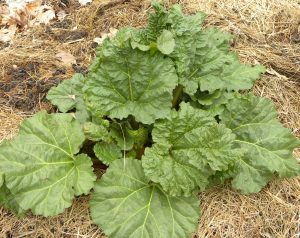
Rhubarb Coming Up, Well-Mulched with Goat Bedding
We cleaned out the barns and coops. We use the deep litter method, so this happens seasonally rather than as a weekly chore. It does make it a big job when the time comes around. All that material – manure and bedding – we use in our gardens and orchards. From the goats we have a lot of bedding hay, with the little goat poop pellets and urine mixed in. It makes a great top-dressed mulch around the fruit trees and some perennials. Poultry manure is higher in nitrogen, a bit messier and can smell, so I either use that in creating new garden beds or put it into the compost to break down some before going to the garden.
Steve is still repairing and adjusting the fencing systems. There have been reports of black bear predation of both bee hives and goats locally, so keeping the electric functioning well has been necessary.
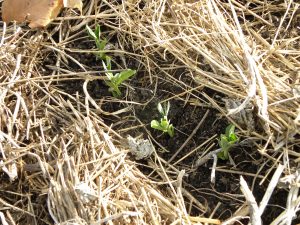
The Peas Are Coming Up!
He has also returned to finishing construction of our newer outbuildings, getting them set up for shuffling of the goats into the new configuration. We moved the boys to their new area which they took in stride. I expected some bleating and running around, but they just slowly checked out every inch of it, then took advantage of the small trees in there to rub in between their horns. The girls’ new area should be ready soon. It has to also have my milking area, so is a lot more complicated. We plan to have it done in time for Lily’s kids to be born there.
Spring is my favorite time for building new soil for garden beds through sheet mulching. We harvested all our compost, plus brought in cardboard, manure, seaweed, coffee grounds and wood chips to continue the process. I have had great success with this technique and love to teach it to people. I have a soil building class scheduled for May 26 here at Living Land which still has plenty of room for more students.
Early spring is also a great time to weed. With all the mulching I do, I don’t have that many weeds, but some sneak through and are easy to spot and pull in their early days.
Off-farm in April, I continued teaching and hosting educational events. I was invited to talk about permaculture for beekeepers to the Winnipesaukee Beekeepers, which I really enjoyed. Through Seacoast Permaculture I helped bring Dr. Fred Wiseman to Portsmouth to discuss his important work and wonderful new book: Seven Sisters and the Heritage Food Systems of the Wabanaki People and of the Chesapeake Bay Region (2018) .
Harvest
We brought in 252 chicken eggs, 72 duck eggs, and 5.7 gallons of milk and made 2 more quarts of salt.
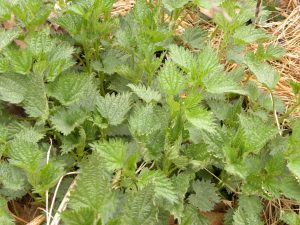
Stinging Nettles – the most nutritious spring green!
From the gardens we’ve enjoyed nettles, chives, savory and sage. While we can see the rhubarb, it’s not big enough to take yet. Any day now!
To prepare for the new bees, I cleaned out the hives that had died and found there was plenty of honey left. I put aside enough to get the new bees started and then extracted about 40 pounds for us. I’d rather have had the living bees, but that much honey eases the loss.
Last year’s bounty is down to garlic, canned fruit and jam, dried beans, dehydrated kale, popcorn, and some lacto-fermented pickles in the fridge. There’s still frozen food that I’ve been forgetting to mention: blueberries, eggplant, beans, broccoli, cauliflower, basil pesto, salsa, and chevre cheese.
This year’s cold April weather kept the leaves off the trees, but brought us few sunny days. We made 574 kwh from the PV solar panels, which did cover our needs but was less than we expected. We are now back in to the part of the year when we are making enough power for our needs and should start putting some in our electric company account for the winter.
Looking Ahead to May
We’ll be welcoming new kids here with Lily expecting in early to mid May. She sure is looking ready! We hope for chicks and maybe getting some duck eggs started. And planting – lots and lots of planting.
We will also be getting ready for an Open Homestead Day in early June that all of you are welcome to attend. Happy Spring!
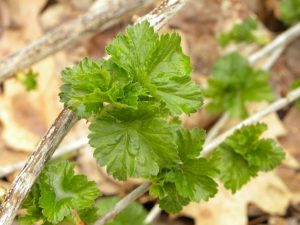
Jostaberry Leaf Opening

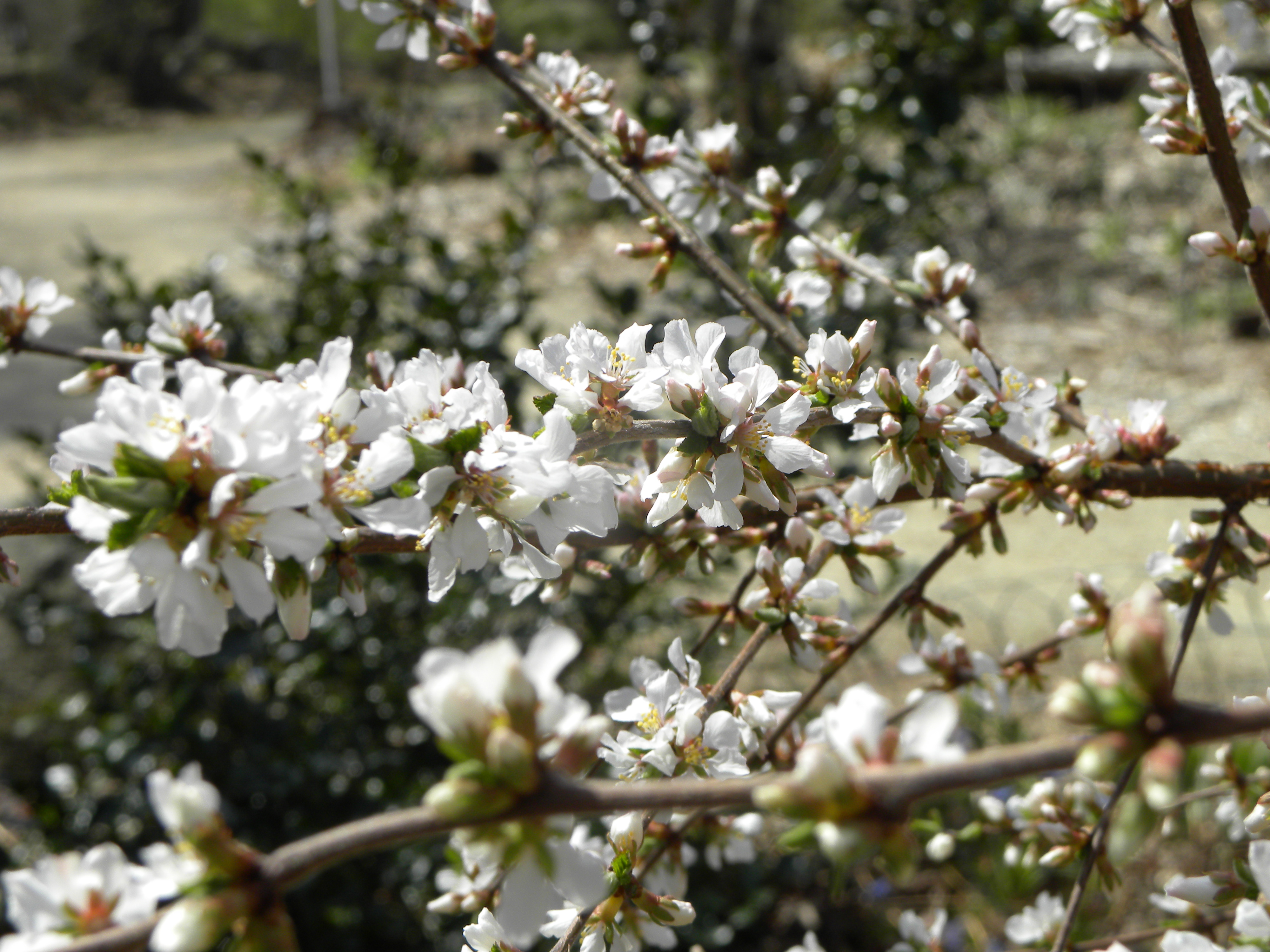

Spring is slow this year, but we’re seeing the fresh green now . I’m always surprised at how exciting it still is when the seasons change.
I’d like to know more about the Nanking Cherry–growth habit and yield.
And now spring is really in full swing!
So, Nanking Cherry – it’s a good sized bush, pruned mostly like a high bush blueberry. I think it would like to grow about 10 feet high, but we keep it shorter with pruning. The yield has varied so far – we had a good year, then last year it flowered, then it got cold so there wasn’t great pollination. I’ll keep better records this year to give more info on how much really comes in. It is a sweet berry, fine fresh eating. It does have a pretty large pit which isn’t particularly edible. Growing it is so easy – we’ve had no disease or pest problems.